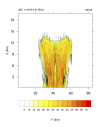I'm wondering if it is possible to tune the monotonic filter for scalar advection? I just added the NSSL 2-moment microphysics to MPAS 7.3, and it shows a familiar issue of noisy edges (oscillations -- especially on strong gradients ), which is pretty obvious in the reflectivity in the ideal supercell test (attached figure). This comes from the number and mass having different errors at the edges, resulting in small numbers of large particles that then fall along the reflectivity boundary. The positive definite filter in addition to the monotonic doesn't seem to affect the result much.
Cranking up the value of config_coef_3rd_order definitely makes the result smoother, and at 1 it is not too bad, but of course there are trade-offs there. Also, is it correct that the namelist options for advection order have no effect (e.g., config_scalar_adv_order)?
Any suggestions?
- Ted

GitHub - MicroTed/MPAS-Model: Repository for MPAS models and shared framework releases. -- branch 'nssl2m'

Cranking up the value of config_coef_3rd_order definitely makes the result smoother, and at 1 it is not too bad, but of course there are trade-offs there. Also, is it correct that the namelist options for advection order have no effect (e.g., config_scalar_adv_order)?
Any suggestions?
- Ted

GitHub - MicroTed/MPAS-Model: Repository for MPAS models and shared framework releases. -- branch 'nssl2m'

